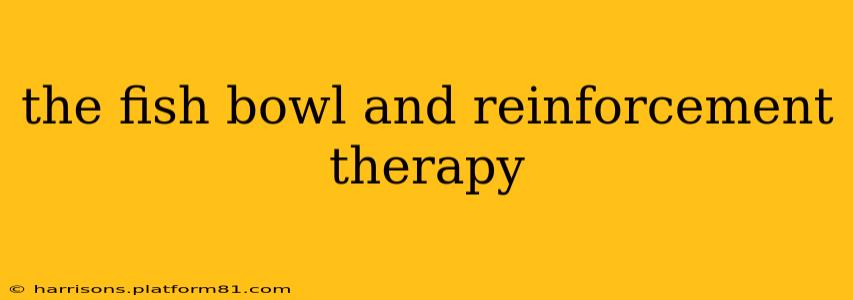The seemingly simple image of a fishbowl, filled with colorful fish swimming in a seemingly endless loop, offers a surprisingly potent analogy for understanding reinforcement therapy. This technique, a cornerstone of behavioral psychology, uses rewards and consequences to shape behavior. While the connection might not be immediately obvious, exploring the parallels between a fishbowl and reinforcement therapy reveals a powerful teaching tool and a deeper understanding of behavior modification.
How Does Reinforcement Therapy Work?
Reinforcement therapy, in its simplest form, revolves around the principle that behaviors followed by desirable consequences (reinforcement) are more likely to be repeated, while behaviors followed by undesirable consequences (punishment) are less likely to be repeated. This is based on the fundamental laws of operant conditioning, pioneered by B.F. Skinner. There are two main types of reinforcement:
- Positive Reinforcement: Adding something desirable to increase a behavior. For example, praising a child for cleaning their room (adding praise) to encourage them to clean their room again.
- Negative Reinforcement: Removing something undesirable to increase a behavior. For example, taking away chores for a week if a child consistently gets good grades (removing chores). Note: This is not punishment. Punishment aims to decrease a behavior, while negative reinforcement aims to increase it.
What Does a Fishbowl Have to Do With It?
The fishbowl represents the environment in which a behavior is learned and maintained. The fish, of course, are the behaviors themselves. Just as the fish are constantly moving within the confines of their bowl, behaviors are repeatedly performed within the context of an individual's environment. The walls of the fishbowl represent the boundaries and limitations of the environment. These boundaries influence which behaviors are reinforced and which are not.
Imagine a fish that repeatedly swims towards the surface because it consistently finds food there. This is analogous to a child who learns to ask politely for a treat because they are always rewarded with one when they do. The "food" (positive reinforcement) shapes the fish's (behavior's) trajectory. Conversely, a fish that bumps into the glass repeatedly (undesirable consequence) might eventually learn to avoid that part of the bowl, mirroring a child learning to avoid a particular behavior due to negative consequences.
What Are Some Different Types of Reinforcement?
Positive Reinforcement Examples:
- Tangible Rewards: Giving a child a toy for good behavior.
- Social Rewards: Praising a student for completing their assignment.
- Activity Rewards: Allowing extra playtime for completing chores.
Negative Reinforcement Examples:
- Removing a disliked chore: Removing a disliked chore after consistent positive behavior.
- Avoiding a stressful situation: A person avoids social gatherings to reduce anxiety. (This is negative reinforcement for avoidance behavior.)
What about punishment? Is that part of the fishbowl analogy?
While the fishbowl primarily illustrates reinforcement, punishment is also a part of behavior modification. In the fishbowl analogy, punishment would be like introducing an unpleasant element into the fishbowl, such as a predator, that discourages certain behaviors. However, effective behavior modification generally emphasizes reinforcement over punishment, as punishment can have unintended negative consequences.
How Effective is Reinforcement Therapy?
The effectiveness of reinforcement therapy varies depending on several factors, including:
- Consistency: Consistent application of reinforcement is crucial.
- Timing: Reinforcement should be given immediately after the desired behavior.
- Individual Differences: What works for one person may not work for another.
- The Severity of the Behavior: More severe behaviors might require more intensive intervention.
Is Reinforcement Therapy Right for Everyone?
Reinforcement therapy isn't a one-size-fits-all solution. It's often highly effective for addressing specific behavioral challenges in children and adults, but it's essential to work with a qualified therapist or behavioral specialist to determine if it's the right approach.
What are the Potential Drawbacks of Reinforcement Therapy?
While generally effective, reinforcement therapy can have potential drawbacks:
- Dependence on Rewards: Over-reliance on external rewards can undermine intrinsic motivation.
- Ethical Considerations: The use of punishment raises ethical concerns, requiring careful consideration and implementation.
- Individual Variability: What works for one individual may not be effective for another.
The fishbowl analogy serves as a simple yet powerful way to understand the core principles of reinforcement therapy. By visualizing behaviors as fish navigating their environment, we gain a clearer picture of how rewards and consequences shape our actions and the actions of those around us. While this is a helpful illustration, always consult with a professional for guidance on addressing specific behavioral challenges.
